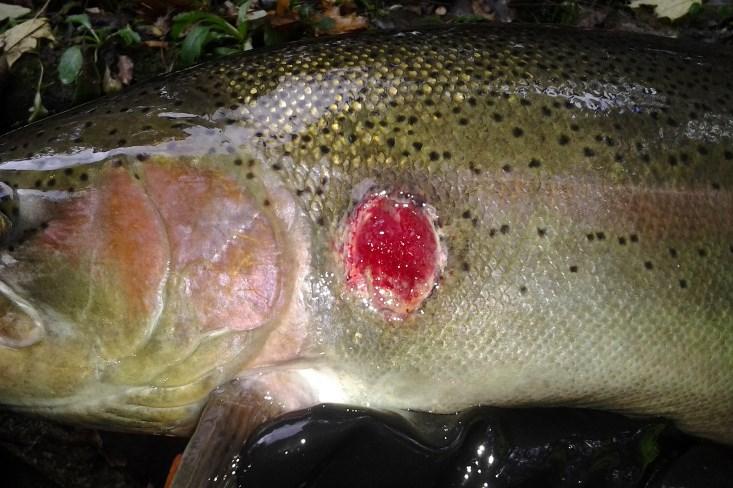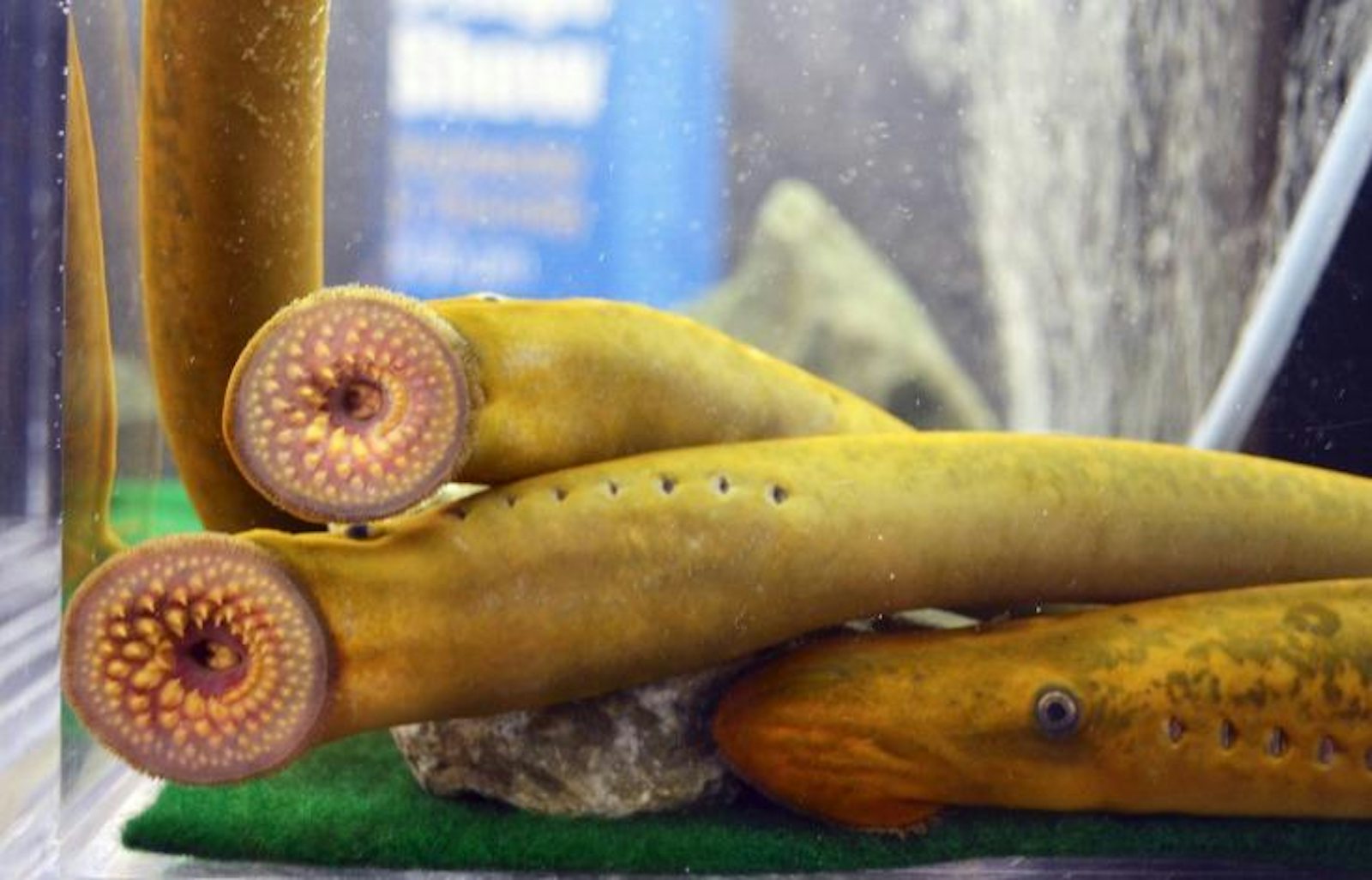
Several years ago, a young man bow-fishing on New Jersey’s Raritan river spotted a long, thin creature in the murky water. He shot the animal through the neck, reeled it in, and posed for photographs. Eventually a friend posted one to Reddit. Within days it went viral, viewed 1.4 million times and setting the internet ablaze with mystery-monster speculation. “Terrifying Sea Monster Found in New Jersey River,” headlined Gawker. The New York Daily News likened the “large, unidentified creature” to “a scene from a sci-fi film.” Some people insisted it was all a hoax.
The creature was, in fact, a common fish called a sea lamprey. The lamprey is admittedly unusual in appearance, with a boneless eel-like body and jawless tooth-ringed mouth, and unusually grotesque when blood-slicked and impaled on a stake. But they’re also well-known residents of coastal waterways throughout eastern North America—which, to be fair, quite a few people pointed out. Yet that there was so much uncertainty, much less Sea Monster!-level horror, reflected the strange mix of ignorance and distortion through which sea lampreys are perceived.
Indeed, in certain circles, there’s no fish more reviled. Ours is not a society kindly disposed to either predators or parasites, and sea lampreys are both: As adults they attach to other fish, using those toothy sucker-mouths to bore holes through which they siphon blood and bodily fluids. They’re blamed for nearly destroying the commercial fisheries of the Great Lakes, where they’ve been subject to a century-long extermination program. Most fishermen and biologists see them as rapacious fish-killers, something to hate and fear.

And yet. Set aside the sea lamprey’s reputation, at least for a moment. Heed the words of biologist John Waldman’s Running Silver, an account of the extraordinary richness of pre-Industrial coastal river life: “Like so many outcasts,” writes Waldman of the lamprey, “it also profoundly misunderstood.” Consider the possibility that even those creatures we most despise may be wellsprings of life, enriching the world in ways we’ve only started to understand. Or, to put it another way, “Anadromous sea lampreys (Petromyzon marinus) are ecosystem engineers in a spawning tributary.”
That’s the title of a paper published last year in the journal Freshwater Biology. Among the co-authors1 is Stephen Coghlan, a University of Maine fisheries ecologist who has spent much of the last eight years studying one Sedgeunkedunk Stream, a tributary of Maine’s great Penobscot River. There the ongoing removal of several large dams has earned national attention, sparking hopes that the Penobscot’s waters might again, per Waldman, run silver with migratory fish.
The same applies on a much smaller scale to Sedgeunkedunk, where an old dam’s dismantling in summer 2009 made it a microcosm of the river system’s potential recovery. Researchers see Sedgeunkedunk as a living laboratory, a before-and-after experiment to see what happens when long-inaccessible waters are reopened. In short: Fish come back (pdf). Alewives, a foundation-of-the-food-chain fish that once swam from the Penobscot to the Atlantic Ocean and back in the billions. Atlantic salmon, iconic and beloved and now almost absent from the river, once so common they were served in poorhouses. And sea lampreys.
“Perhaps when trout and salmon populations were robust, when they had access to clean water and spawning habitat, they could withstand some amount of lamprey predation,” says Coghlan. Their exploding numbers, then, were only a consequence of ecological upheaval, not its cause.
Before coming to Maine, Coghlan worked in western New York, in the Great Lakes watershed, where the conventional American wisdom2 on sea lampreys was conceived following the late-19th- and early-20th-century collapse of world-renowned trout populations. The lampreys were invasive, having infiltrated the region through shipping canals; Great Lakes fish could not adapt to their ravages. Historical records describe the ease with which nets could be lowered to lake bottoms, then pulled back up with a cargo of sea lamprey-holed carcasses. “They were the scourge,” says Coghlan. Great Lakes fish are now sustained by a constant, watershed-scale campaign of poisoning the streams where the invaders spawn.
In the middle of the last decade, though, a series of studies led by John Waldman challenged that simple narrative. By comparing the genomes of the Great Lakes and Atlantic-seaboard lamprey, Waldman and colleagues were able to reconstruct their population histories—and the resulting family trees suggested that sea lampreys were in fact native to Lake Ontario, the easternmost of the Great Lakes, as well as Lake Champlain and the nearby Finger Lakes, where they have also been, erroneously, considered invasive.
Yes, at some point sea lampreys swam from Lake Ontario through the Welland Canal and into the other Great Lakes, and there caused havoc. That’s indisputable. Yet in some places, they were not invaders, but instead had been present for thousands of years. Which raised the question: If sea lamprey are so terrible, and lived there all along, why wasn’t Lake Ontario a lamprey-dominated wreck to begin with? Why did its once-flourishing fisheries collapse only recently?
An alternative explanation, says Coghlan, is that Lake Ontario’s lamprey explosion was simply the last in a chain of ecological insults, and made possible by those that preceded it. European settlers had harvested the lake’s fish with their usual foresight and regard for nature’s limits—which is to say, none at all. They built dams across streams and creeks, blocking trout and salmon from their spawning grounds. The dams powered sawmills that processed timber cleared from surrounding countryside. Subsequent soil erosion clouded lake and stream waters. Mills and forest-replacing farms added yet more pollution, creating conditions unfavorable to other fish but readily tolerated by lamprey.
Perhaps most destructively, alewives got into the system, likely introduced as a food source for commercially favored fish. They soon outcompeted native small fish, so that trout and salmon had little else to eat—but alewives, it turns out, contain high concentrations of thiamine, which causes nervous system damage and birth defects in predators who consume too many. In coastal systems, where predators co-evolved with alewives and there’s greater dietary variety, it’s not a big problem. In the Great Lakes, it was a toxic recipe.
“Perhaps when trout and salmon populations were robust, when they had access to clean water and spawning habitat, they could withstand some amount of lamprey predation,” says Coghlan. “But now there was this shift. Maybe with all these man-made changes, lamprey just flourished.” Their exploding numbers, then, were only a consequence of ecological upheaval, not its cause. Far from one-dimensional villains, they’re a sort of victim.
Or so the explanation goes. Coghlan is quick to note that it’s just a hypothesis, albeit a very plausible one supported by ever-more evidence. Regardless, sea lampreys remain widely persecuted today, the original Great Lakes narrative being internalized far and wide. Yet at least a few biologists have come to question whether, particularly in coastal regions, they’re indeed so destructive.
At Sedgeunkedunk, Coghlan wasn’t tasked with killing lampreys. He was just there to study them, beginning with their migratory return each spring in May or June, swimming upstream via the Penobscot from an adulthood spent in the Atlantic Ocean. They might be 15 or 20 years old, and these are their last weeks. Already their eyes and digestive systems are starting to break down. They’ve enough strength left for one final burst of mating and, crucially, nest-building.
The nests consist of a mound of rocks—some the size of softballs, pulled from surrounding streambeds and thrashed into place—and, on the downstream side, a long pit into which eggs are laid and fertilized. As described and empiricized in that Freshwater Biology article, all this digging and dragging dislodges small insects and other aquatic invertebrates, which become food for larger insects, and also for salmon that line up behind the spawning lamprey, eating dim sum-style.
Above the nest, the stream’s hydrology also changes. Water flows slowly over the pit but fast over the mound, clearing it of silt. Pockets and hollows between pebbles in the mound become prime habitat for midges, caddisflies, mayflies—foundational creatures. Lamprey nest-building doesn’t seem to increase the total population of these insects; rather, it concentrates them, creating comparatively energy-rich regions where insect-eating fish can feed at high efficiency, packing on as much nutrition as possible before their own migratory journey out to sea.

Video credit: Stephen Coghlan, University of Maine
If that’s a fine point, it’s more obvious what happens when the lampreys finish spawning. They die. Their bodies fall to the streambed, where they decompose and are consumed—rich nutrient bursts, delivered from the deep sea. In one Massachusetts stream (pdf), a few hundred sea lamprey corpses provided a full 20 percent of the system’s total phosphorus, and more than one ton of minerals and nutrients. Just as important is timing: Nests are built and bodies fall just as trees grow out overhead, their canopies blocking sunlight from reaching the stream—which in turn stifles the growth of photosynthetic algae, a decrease that ripples through the food web.
“From spring to summer the energy balance of the stream goes from higher energy demand to lower energy availability,” explains Coghlan, and the lamprey help tilt it back. One can imagine lines of energy radiating outwards from them, into insects and fish, and then all the creatures who eat them, out into the river to the deep Atlantic Ocean and back again, a perpetual feedback loop of life.
Might sea lampreys play a similar forest-vivifying role as migrating salmon once did on the Pacific coast? They’re likely not quite that powerful, says Coghlan, but they’re still very important.3 Keystone species, even, with disproportionately large influence on their communities of life, like wolves or elephants or beavers.
All this is coming to light at a moment when dams are finally being removed and rivers long constricted restored to life. In this effort, people have focused on the most charismatic fish, the salmon and shad and alewives. Yet perhaps the sea lamprey’s unappreciated efforts are necessary for those other fish to thrive. Rather than destroying life, they nourish it. Which raises one more question: How many other creatures, loathed like sea lampreys or simply unnoticed, in fact make our world a far richer place?
Footnotes:
1. Also including lead author Robert Hogg of the University of Maine; Joseph Zydlewski of the U.S. Geological Survey; and Kevin Simon at the University of Auckland, New Zealand.
2. In Europe, they’re considered a welcome delicacy.
3. There are Pacific lamprey, too: Entosphenus tridentatus, now endangered. Whether they play a similar ecological role as their Atlantic counterparts is unknown, but they too are migratory nest-builders.
Brandon Keim is a freelance journalist who writes about science, technology, and nature. His work has appeared in Wired, Aeon, Scientific American Mind, and other publications.




























